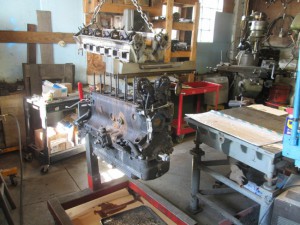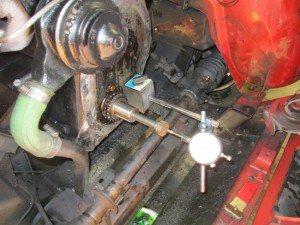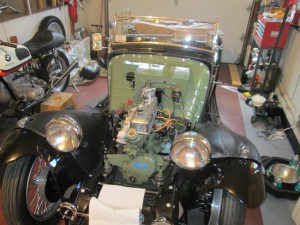Sometimes we need to use the chain hoist to lift the cylinder head on a DOHC Jaguar engine. 45 years of carbon build up and corrosion made it the preferred method on this one. From what we know, it has spent most of its life sitting, not all of it under favorable storage conditions.
By the end of the week everything should be torn down and either prepped for the machine shop or boxed for cleaning and prep work. The parts which are machine shop-bound, the crankshaft, connecting rods main bearing caps & flywheel all get washed and run thru the glassbead cabinet. We’ve already marked the cam followers for relative position and noted the sizes of the various valve adjustment pallets, along with their locations. It’s a real time saver when setting up the head again during reassembly.
Triumph Spitfires and TR250’s & TR6’s are notorious for excessive crankshaft end float and thrust washer problems. In fact more than one TR6 has shown up here with the thrust washers in the oil pan. We usually set the thrust clearance on MG’s & Austin Healeys within a range of about .0025″ to .004″.
On these Triumph engines the specification is .006″ to .008″. It’s a taddy-bit wide, me thinks.
When these engines have calved big time in the past we’ve been fortunate to be able to have the machine shop repair the damage to the crankshaft flange and rear main cap & cylinder block by welding. Best practice, in my judgement, is to stake the thrust washers to the bearing cap or block so they can’t start spinning around and fall out. John measured the thrust on this engine at just under .010″.
Here’s a picture taken on location in Larry Perry’s garage, which is just wide enough for his MG TC and BMW motorcycle. It’s tough to know how many miles are on the TC, but Larry has documented over 300,000 miles on the BMW. We’re prepping the MG for his next Shorrock supercharger.
Late in 1945 MG cleared away the armorment work from the factory floor, laid down an assembly line and starting building sportscars again. For reasons probably having a lot to do with the availability of materials, these early cars were painted black but their engines and bulkheads were an olive green, perhaps a War-Surplus color available on the cheap. At some point later on bulkheads began to be painted body color and engines MG Red.
You can read more in Mike Sherrill’s exhaustively thorough book “TC’s Forever”
Butch has been assidulously working to button up the Jaguar Mk IX sedan as noted here on this page from time to time. Just as it appeared the end was in sight on Thursday (and also the reason for the tardy appearance of this missive, I was out late chasing parts), another small wrinkle came to light in the form of a severely bent hub… Click for Video






